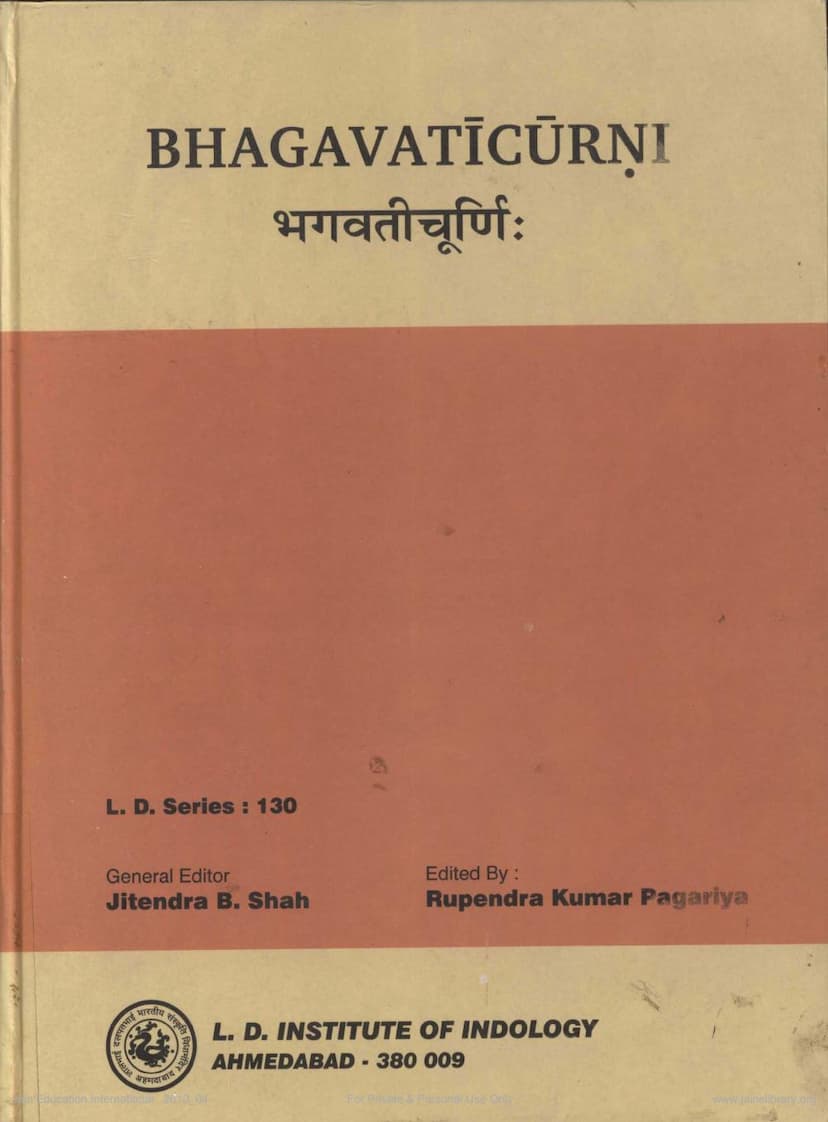Agam 05 Ang 05 Bhagvati Vyakhya Prajnapti Sutra Churni
Added to library: September 1, 2025

Summary
This document is a scanned copy of the Bhagavaticurni (भगवतीचूर्णिः), a commentary on the Jain Agama (canonical text) called the Bhagavati Sutra (also known as Vyakhya Prajnapti Sutra).
Here's a breakdown of the key information presented in the initial pages:
- Title: Bhagavati Curni (भगवतीचूर्णिः)
- Author: Sthaviracharya (स्थविर आचार्य) is credited as the original author of the Curni.
- Editor: Rupendra Kumar Pagariya (रूपेन्द्रकुमार पगारिया) is the editor of this particular printed edition.
- Publisher: L. D. Institute of Indology, Ahmedabad (लालभाई दलपतभाई भारतीय संस्कृति विद्यामन्दिर, अहमदाबाद).
- Series: L. D. Series: 130
- General Editor: Jitendra B. Shah (जितेन्द्र बी. शाह)
- First Edition: January, 2002
- ISBN: 81-85857-12-1
- Price: Rs. 150
- Catalog Link: https://jainqq.org/explore/002595/1 (This link is provided for reference, likely for further information or access).
- Purpose: JAIN EDUCATION INTERNATIONAL FOR PRIVATE AND PERSONAL USE ONLY.
Key points from the introductory sections (प्रकाशकीय - Editorial, and सम्पादकीय - Editor's Note):
- Significance: The Bhagavati Sutra is described as a significant and voluminous Jain Agama. The Curni (commentary) on it was previously unpublished due to the complexity of the original text and the specialized style of the Curni itself.
- Editing Process: Pandit Rupendra Kumar Pagariya took on the challenging task of editing this Curni. He utilized five paper manuscripts, four from the Shri Hemchandracharya Jnana Bhandar (Patan) and one from the L. D. Institute of Indology (Ahmedabad).
- Oldest Manuscript: The oldest manuscript used dates back to 1495 VS (Vikram Samvat), written on palm leaves (though the description later clarifies they are paper manuscripts, this might be a slight inconsistency or refer to an earlier tradition of script). It was written under the guidance of Acharya Shri Jinabhadr Suri and commissioned by a Shri Malgotriya Shrada family.
- Challenges in Editing: The editor faced significant difficulties due to the age and quality of the manuscripts. The manuscripts were xerox copies, had unclear black spots, and some pages were unreadable. The editor notes that errors found in the oldest manuscript were replicated in other copies, suggesting they were likely derived from the same source. There were also consistent errors in letter substitutions (e.g., 'p' for 'y', 'y' for 'p', 'ch' for 'v', 'v' for 'ch', 's' for 'm', 'm' for 's') and inconsistencies in numbering and tables of permutations.
- Nature of the Curni: The Curni is described as a concise summary of the vast Bhagavati Sutra, presented in a compressed form, like filling an ocean into a pot. It focuses on the essence of the text.
- Content of Bhagavati Sutra: It is the fifth Anga Sutra, presented in a question-and-answer format between Lord Mahavir and Gautam Gandhar. It is said to contain solutions to 36,000 questions and covers topics like self-time, other-time, soul, non-soul, world, non-world, etc. It includes question-and-answer sessions with gods, kings, sages, mendicants, lay disciples, and detailed character descriptions of cities, kings, queens, forests, etc.
- Curnikara's Approach: The Curnikara (commentator) omitted descriptive narratives and character descriptions, except for a brief mention of Gosala. Key figures like Jayanti Shravika, Somil, Kartik Sheth, and Jamali are only named, with their questions answered concisely. The Curnikara also provided brief answers to questions from all "Uddeshaks" (sections) of the Bhagavati Sutra. The commentary mainly relies on the Prajnapana Sutra and includes only about 10-12 ancient verses.
- Identity of the Curnikara: The identity of the Curnikara is uncertain as the text itself does not mention the author. While there's a tradition that Curnis are often authored by Shri Jinasenagani Mahattar, the editor speculates that this Curni might be the work of an earlier Acharya due to its concise nature, contrasting with other extensive Curnis by Jinasenagani.
- Time Period: The Curni is estimated to be from before the 11th century, as Acharya Abhaydev Suri referenced this Curni in his commentary written in 9028 VS (which would be around the 11th century CE). The language also reflects changes over time, with many words appearing in their Prakritized forms. The commentator sometimes uses Sanskrit and a mix of Prakrit and Sanskrit in a philosophical style to support theoretical points.
- Understanding the Text: Understanding this concise Curni requires prior study of the Bhagavati Sutra, its commentaries, and the Prajnapana Sutra.
- Editor's Appeal: The editor apologizes for potential errors due to the editing challenges and asks readers to point out any mistakes. He also thanks the institutions that helped in obtaining the manuscripts and publishing the work.
The subsequent pages (starting from Page #12) contain the actual commencement of the Curni itself, written in Prakrit (with some Sanskrit mixed in), detailing various Jain philosophical concepts, classifications, and discussions, often in a technical and enumerative style. It covers a wide range of topics related to the Bhagavati Sutra, including:
- Classification of beings: Based on senses, lifespan, states of existence, etc.
- Karma theory: Discussing bonds, types of karma, duration, and shedding of karma.
- Cosmology: Descriptions of the universe, realms of existence, measurements, etc.
- Soul and matter: Their nature, attributes, and interactions.
- Knowledge and Perception: Various types of knowledge (Jnana) and cognitive faculties.
- Moral conduct and austerities: Discussing the path to liberation.
- Subtle philosophical arguments and classifications of various elements of Jain ontology and cosmology.
This is a highly technical and detailed work, characteristic of classical Jain commentaries. The summary here provides a general overview of the introductory material and the nature of the content presented.